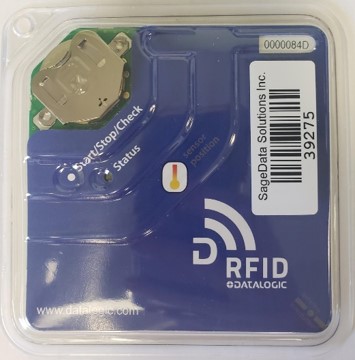Introduction to an automated temperature logging
SageData is based in Ottawa, Ontario, Canada
We use the term Temperature Loggers to refer to small self contained devices that
automatically measure and record
temperatures. These may be made available
immediately, but the prime purpose is to produce a record of temperature over time, usually to
confirm compliance with a
pre-defined set of limits.
There are currently three different ways to track temperature, RFID (HF), RFID (UHF), and
BLE - Bluetooth Low Energy.
Each have their strengths.
RFID HF
This is a good solution for measuring ambient temperature throughout the cold chain.
Passive tags are
mounted at convenient locations. No battery is required. Reading is by means
of a handheld computer.
The range of an HF tag is limited, usually to a few inches, but that is an advantage in
this case, where there may be
multiple tags in close proximity. A handheld computer is used to read the tag. The application
on
the handheld computer
is set to read, and the user places the handheld computer close to the tag. The current
temperature is then recorded.
RFID UHF
These tags include a small battery which powers a low current circuit that is
programmed to
measure and
record a temperature at predefined intervals.
 Typically this might be once
per hour. Communication with the logging tag is by means of a conventional UHF RFID channel,
which
means that the
batteries are used solely for recording of data - giving a very long working
life, which can be several years, dependent on settings.
Typically this might be once
per hour. Communication with the logging tag is by means of a conventional UHF RFID channel,
which
means that the
batteries are used solely for recording of data - giving a very long working
life, which can be several years, dependent on settings.
As with HF tags, these are best read using a mobile handheld computer. Range is
greater with UHF, and can
be up to several meters, but this can be problematic when several tags are
used close together,so range is often deliberately limited.
BLE - Bluetooth Low Energy
These tags are battery powered, and work by taking a temperature at a pre defined
cycle,
and then
transmitting that temperature to a fixed reader. In general, BLE tags are capable of recording
presence, temperature and light levels.
The reader will know the identity of the tag, and
the
current temperature.
Advantages and disadvantages
The HF tags are the simplest solution, they need zero maintenance,
and there is no concern about battery life.
The UHF option provides more
readings, and can be read at a greater range. Tags are slightly more expensive. Battery life
introduces an extra
variable. It has another benefit - the data collection is usually performed by
an individual who is also performing a routine inspection - and so it provides a confirmation of
that all locations were visited.
BLE simplifies the reading process, but is
more dependent on setup, and again the tags can be slightly more expensive.
Reporting Temperature
SageData Solutions offers software that can be local,
standalone, networked or on the cloud based
servers that interact with the handheld computers to set them up, and to collect and analyze
data.
Temperatures can be set for high and low
limits, and the reporting system will provide a variety of reports, including summary reports,
exception reports, or
detailed history reports. These include the identity of the individual
taking the readings.

Please let us know if you would like to learn more.
If you found this useful, you might also want to review:
- an introduction to RFID- RFID read range
- BLE for asset tracking
- RFID tags
QAOK3167-8
